Decoding the Role of Melatonin Structure on Plasmodium falciparum Human Malaria Parasites Synchronization Using 2-Sulfenylindoles Derivatives
Abstract
1. Introduction
2. Materials and Methods
2.1. Plasmodium Falciparum Culture
2.2. In Vitro Drug Susceptibility Assay
2.3. Cytotoxicity Assay
2.4. Effects of Indole Derivatives on Parasitemia
2.5. Blood-Stage Development Evaluation by Microscopy
2.6. Real-Time PCR and Data Analysis
2.7. Data Analysis
3. Results
3.1. Antiplasmodial Activity of 2-sulfenylindoles against CQS (3D7) and CQR (Dd2) Parasites
3.2. Effect of 2-sulfenylindoles on the Parasitemia of 3D7 Parasites
3.3. Effect of 2-sulfenylindoles in Combination with Melatonin on the Parasitemia
3.4. Cytotoxic Activity of 2-sulfenylindoles on Mammalian Cells
3.5. Effect on Blood-Stage Growth Progression of the Most Active Compounds
3.6. Indole Compound Melatonin Alters the Expression of Plasmodium Transcript
4. Discussion
5. Conclusions
Supplementary Materials
Author Contributions
Funding
Institutional Review Board Statement
Informed Consent Statement
Data Availability Statement
Acknowledgments
Conflicts of Interest
References
- WHO. World Malaria Reports 2016; World Health Organization: Geneva, Switzerland, 2020. [Google Scholar]
- Blasco, B.; Leroy, D.; Fidock, D.A. Antimalarial drug resistance: Linking Plasmodium falciparum parasite biology to the clinic. Nat. Med. 2017, 23, 917–928. [Google Scholar] [CrossRef]
- Tse, E.G.; Korsik, M.; Todd, M.H. The past, present and future of anti-malarial medicines. Malar. J. 2019, 18, 93. [Google Scholar] [CrossRef] [PubMed]
- Chadha, N.; Silakari, O. Indoles as therapeutics of interest in medicinal chemistry: Bird’s eye view. Eur. J. Med. Chem. 2017, 134, 159–184. [Google Scholar] [CrossRef] [PubMed]
- Garg, V.; Maurya, R.K.; Thanikachalam, P.V.; Bansal, G.; Monga, V. An insight into the medicinal perspective of synthetic analogs of indole: A review. Eur. J. Med. Chem. 2019, 180, 562–612. [Google Scholar] [CrossRef] [PubMed]
- Hotta, C.T.; Gazarini, M.L.; Beraldo, F.H.; Varotti, F.P.; Lopes, C.; Markus, R.P.; Pozzan, T.; Garcia, C.R. Calcium-dependent modulation by melatonin of the circadian rhythm in malarial parasites. Nat. Cell Biol. 2000, 2, 466–468. [Google Scholar] [CrossRef]
- Bagnaresi, P.; Alves, E.; da Silva, H.B.; Epiphanio, S.; Mota, M.M.; Garcia, C.R. Unlike the synchronous Plasmodium falciparum and P. chabaudi infection, the P. berghei and P. yoelii asynchronous infections are not affected by melatonin. Int. J. Gen. Med. 2009, 2, 47–55. [Google Scholar] [CrossRef]
- Beraldo, F.H.; Almeida, F.M.; da Silva, A.M.; Garcia, C.R. Cyclic AMP and calcium interplay as second messengers in melatonin-dependent regulation of Plasmodium falciparum cell cycle. J. Cell Biol. 2005, 170, 551–557. [Google Scholar] [CrossRef]
- Budu, A.; Peres, R.; Bueno, V.B.; Catalani, L.H.; Garcia, C.R. N1-acetyl-N2-formyl-5-methoxykynuramine modulates the cell cycle of malaria parasites. J. Pineal Res. 2007, 42, 261–266. [Google Scholar] [CrossRef]
- Schuck, D.C.; Jordao, A.K.; Nakabashi, M.; Cunha, A.C.; Ferreira, V.F.; Garcia, C.R. Synthetic indole and melatonin derivatives exhibit antimalarial activity on the cell cycle of the human malaria parasite Plasmodium falciparum. Eur. J. Med. Chem. 2014, 78, 375–382. [Google Scholar] [CrossRef]
- Campos, P.E.; Pichon, E.; Moriou, C.; Clerc, P.; Trepos, R.; Frederich, M.; De Voogd, N.; Hellio, C.; Gauvin-Bialecki, A.; Al-Mourabit, A. New Antimalarial and Antimicrobial Tryptamine Derivatives from the Marine Sponge Fascaplysinopsis reticulata. Mar. Drugs 2019, 17, 167. [Google Scholar] [CrossRef]
- Furuyama, W.; Enomoto, M.; Mossaad, E.; Kawai, S.; Mikoshiba, K.; Kawazu, S. An interplay between 2 signaling pathways: Melatonin-cAMP and IP3-Ca2+ signaling pathways control intraerythrocytic development of the malaria parasite Plasmodium falciparum. Biochem. Biophys. Res. Commun. 2014, 446, 125–131. [Google Scholar] [CrossRef]
- Luthra, T.; Nayak, A.K.; Bose, S.; Chakrabarti, S.; Gupta, A.; Sen, S. Indole based antimalarial compounds targeting the melatonin pathway: Their design, synthesis and biological evaluation. Eur. J. Med. Chem. 2019, 168, 11–27. [Google Scholar] [CrossRef] [PubMed]
- Agarwal, A.; Srivastava, K.; Puri, S.K.; Chauhan, P.M. Synthesis of substituted indole derivatives as a new class of antimalarial agents. Bioorg. Med. Chem. Lett. 2005, 15, 3133–3136. [Google Scholar] [CrossRef] [PubMed]
- Zhu, J.; Chen, T.; Chen, L.; Lu, W.; Che, P.; Huang, J.; Li, H.; Li, J.; Jiang, H. 2-amido-3-(1H-indol-3-yl)-N-substituted-propanamides as a new class of falcipain-2 inhibitors. 1. Design, synthesis, biological evaluation and binding model studies. Molecules 2009, 14, 494–508. [Google Scholar] [CrossRef]
- Lebar, M.D.; Hahn, K.N.; Mutka, T.; Maignan, P.; McClintock, J.B.; Amsler, C.D.; van Olphen, A.; Kyle, D.E.; Baker, B.J. CNS and antimalarial activity of synthetic meridianin and psammopemmin analogs. Bioorg. Med. Chem. 2011, 19, 5756–5762. [Google Scholar] [CrossRef]
- Bharate, S.B.; Yadav, R.R.; Khan, S.I.; Tekwani, B.L.; Jacob, M.R.; Khan, I.A.; Vishwakarma, R.A. Meridianin G and its analogs as antimalarial agents. MedChemComm 2013, 4, 1042–1048. [Google Scholar] [CrossRef]
- Devender, N.; Gunjan, S.; Tripathi, R.; Tripathi, R.P. Synthesis and antiplasmodial activity of novel indoleamide derivatives bearing sulfonamide and triazole pharmacophores. Eur. J. Med. Chem. 2017, 131, 171–184. [Google Scholar] [CrossRef]
- Dias, B.K.; Nakabashi, M.; Alves, M.R.R.; Portella, D.P.; Dos Santos, B.M.; Costa da Silva Almeida, F.; Ribeiro, R.Y.; Schuck, D.C.; Jordão, A.K.; Garcia, C.R. The Plasmodium falciparum eIK1 kinase (PfeIK1) is central for melatonin synchronization in the human malaria parasite. Melatotosil blocks melatonin action on parasite cell cycle. J. Pineal Res. 2020, 69, e12685. [Google Scholar] [CrossRef]
- Fernandez, L.S.; Buchanan, M.S.; Carroll, A.R.; Feng, Y.J.; Quinn, R.J.; Avery, V.M. Flinderoles A-C: Antimalarial bis-indole alkaloids from Flindersia species. Org. Lett. 2009, 11, 329–332. [Google Scholar] [CrossRef]
- Fernandez, L.S.; Sykes, M.L.; Andrews, K.T.; Avery, V.M. Antiparasitic activity of alkaloids from plant species of Papua New Guinea and Australia. Int. J. Antimicrob. Agents 2010, 36, 275–279. [Google Scholar] [CrossRef]
- Turner, H. Spiroindolone NITD609 is a novel antimalarial drug that targets the P-type ATPase PfATP4. Future Med. Chem. 2016, 8, 227–238. [Google Scholar] [CrossRef] [PubMed]
- Santos, M.S.; Betim, H.L.I.; Kisukuri, C.M.; Campos Delgado, J.A.; Correa, A.G.; Paixao, M.W. Photoredox Catalysis toward 2-Sulfenylindole Synthesis through a Radical Cascade Process. Org. Lett. 2020, 22, 4266–4271. [Google Scholar] [CrossRef] [PubMed]
- Carmichael, J.; DeGraff, W.G.; Gazdar, A.F.; Minna, J.D.; Mitchell, J.B. Evaluation of a tetrazolium-based semiautomated colorimetric assay: Assessment of chemosensitivity testing. Cancer Res. 1987, 47, 936–942. [Google Scholar] [PubMed]
- Schuck, D.C.; Ferreira, S.B.; Cruz, L.N.; Da Rocha, D.R.; Moraes, M.S.; Nakabashi, M.; Rosenthal, P.J.; Ferreira, V.F.; Garcia, C.R. Biological evaluation of hydroxynaphthoquinones as anti-malarials. Malar. J. 2013, 12, 234. [Google Scholar] [CrossRef]
- Koyama, F.C.; Azevedo, M.F.; Budu, A.; Chakrabarti, D.; Garcia, C.R. Melatonin-induced temporal up-regulation of gene expression related to ubiquitin/proteasome system (UPS) in the human malaria parasite Plasmodium falciparum. Int. J. Mol. Sci. 2014, 15, 22320–22330. [Google Scholar] [CrossRef] [PubMed]
- Scarpelli, P.H.; Tessarin-Almeida, G.; Viçoso, K.L.; Lima, W.R.; Borges-Pereira, L.; Meissner, K.A.; Wrenger, C.; Raffaello, A.; Rizzuto, R.; Pozzan, T.; et al. Melatonin activates FIS1, DYN1, and DYN2 Plasmodium falciparum related-genes for mitochondria fission: Mitoemerald-GFP as a tool to visualize mitochondria structure. J. Pineal Res. 2019, 66, e12484. [Google Scholar] [CrossRef]
- Singh, M.K.; Tessarin-Almeida, G.; Dias, B.K.; Pereira, P.S.; Costa, F.; Przyborski, J.M.; Garcia, C.R. A nuclear protein, PfMORC confers melatonin dependent synchrony of the human malaria parasite P. falciparum in the asexual stage. Sci. Rep. 2021, 11, 2057. [Google Scholar] [CrossRef]
- Hotta, C.T.; Markus, R.P.; Garcia, C.R. Melatonin and N-acetyl-serotonin cross the red blood cell membrane and evoke calcium mobilization in malarial parasites. Braz. J. Med. Biol. Res. 2003, 36, 1583–1587. [Google Scholar] [CrossRef]
- Alves, E.; Bartlett, P.J.; Garcia, C.R.; Thomas, A.P. Melatonin and IP3-induced Ca2+ release from intracellular stores in the malaria parasite Plasmodium falciparum within infected red blood cells. J. Biol. Chem. 2011, 286, 5905–5912. [Google Scholar] [CrossRef]
- Collins, C.R.; Hackett, F.; Strath, M.; Penzo, M.; Withers-Martinez, C.; Baker, D.A.; Blackman, M.J. Malaria parasite cGMP-dependent protein kinase regulates blood stage merozoite secretory organelle discharge and egress. PLoS Pathog. 2013, 9, e1003344. [Google Scholar] [CrossRef]
- Hawking, F.; Gammage, K.; Worms, M.J. The asexual and sexual circadian rhythms of Plasmodium vinckei chabaudi, of P. berghei and of P. gallinaceum. Parasitology 1972, 65, 189–201. [Google Scholar] [CrossRef] [PubMed]
- Garcia, C.R.; Markus, R.P.; Madeira, L. Tertian and quartan fevers: Temporal regulation in malarial infection. J. Biol. Rhythms 2001, 16, 436–443. [Google Scholar] [CrossRef] [PubMed]
- Mideo, N.; Reece, S.E.; Smith, A.L.; Metcalf, C.J. The Cinderella syndrome: Why do malaria-infected cells burst at midnight? Trends Parasitol. 2013, 29, 10–16. [Google Scholar] [CrossRef] [PubMed]
- Borges-Pereira, L.; Budu, A.; McKnight, C.A.; Moore, C.A.; Vella, S.A.; Triana, M.A.H.; Liu, J.; Garcia, C.R.; Pace, D.A.; Moreno, S.N. Calcium Signaling throughout the Toxoplasma gondii Lytic Cycle: A study using genetically encoded calcium indicators. J. Biol. Chem. 2015, 290, 26914–26926. [Google Scholar] [CrossRef] [PubMed]
- Canepa, G.E.; Degese, M.S.; Budu, A.; Garcia, C.R.; Buscaglia, C.A. Involvement of TSSA (trypomastigote small surface antigen) in Trypanosoma cruzi invasion of mammalian cells. Biochem. J. 2012, 444, 211–218. [Google Scholar] [CrossRef]
- Beraldo, F.H.; Mikoshiba, K.; Garcia, C.R. Human malarial parasite, Plasmodium falciparum, displays capacitative calcium entry: 2-aminoethyl diphenylborinate blocks the signal transduction pathway of melatonin action on the P. falciparum cell cycle. J. Pineal Res. 2007, 43, 360–364. [Google Scholar] [CrossRef] [PubMed]
- Pecenin, M.F.; Borges-Pereira, L.; Levano-Garcia, J.; Budu, A.; Alves, E.; Mikoshiba, K.; Thomas, A.; Garcia, C.R. Blocking IP3 signal transduction pathways inhibits melatonin-induced Ca2+ signals and impairs P. falciparum development and proliferation in erythrocytes. Cell Calcium. 2018, 72, 81–90. [Google Scholar] [CrossRef]
- Gazarini, M.L.; Beraldo, F.H.; Almeida, F.M.; Bootman, M.; Da Silva, A.M.; Garcia, C.R. Melatonin triggers PKA activation in the rodent malaria parasite Plasmodium chabaudi. J. Pineal Res. 2011, 50, 64–70. [Google Scholar] [CrossRef]
- Koyama, F.C.; Ribeiro, R.Y.; Garcia, J.L.; Azevedo, M.F.; Chakrabarti, D.; Garcia, C.R. Ubiquitin proteasome system and the atypical kinase PfPK7 are involved in melatonin signaling in Plasmodium falciparum. J. Pineal Res. 2012, 53, 147–153. [Google Scholar] [CrossRef]
- Greischar, M.A.; Read, A.F.; Bjornstad, O.N. Synchrony in malaria infections: How intensifying within-host competition can be adaptive. Am. Nat. 2014, 183, E36–E49. [Google Scholar] [CrossRef]
- Van de Walle, T.; Boone, M.; Van Puyvelde, J.; Combrinck, J.; Smith, P.J.; Chibale, K.; Mangelinckx, S.; D’hooghe, M. Synthesis and biological evaluation of novel quinoline-piperidine scaffolds as antiplasmodium agents. Eur. J. Med. Chem. 2020, 198, 112330. [Google Scholar] [CrossRef]
- De Souza, N.B.; Carmo, A.M.; da Silva, A.D.; Franca, T.C.; Krettli, A.U. Antiplasmodial activity of chloroquine analogs against chloroquine-resistant parasites, docking studies and mechanisms of drug action. Malar. J. 2014, 13, 469. [Google Scholar] [CrossRef] [PubMed][Green Version]
- Prajapati, S.P.; Kaushik, N.K.; Zaveri, M.; Mohanakrishanan, D.; Kawathekar, N.; Sahal, D. Synthesis, characterization and antimalarial evaluation of new β-benzoylstyrene derivatives of acridine. Arab. J. Chem. 2017, 10, S274–S280. [Google Scholar] [CrossRef]
- Ngemenya, M.N.; Abwenzoh, G.N.; Ikome, H.N.; Zofou, D.; Ntie-Kang, F.; Efange, S.M.N. Structurally simple synthetic 1, 4-disubstituted piperidines with high selectivity for resistant Plasmodium falciparum. BMC Pharmacol. Toxicol. 2018, 19, 42. [Google Scholar] [CrossRef] [PubMed]


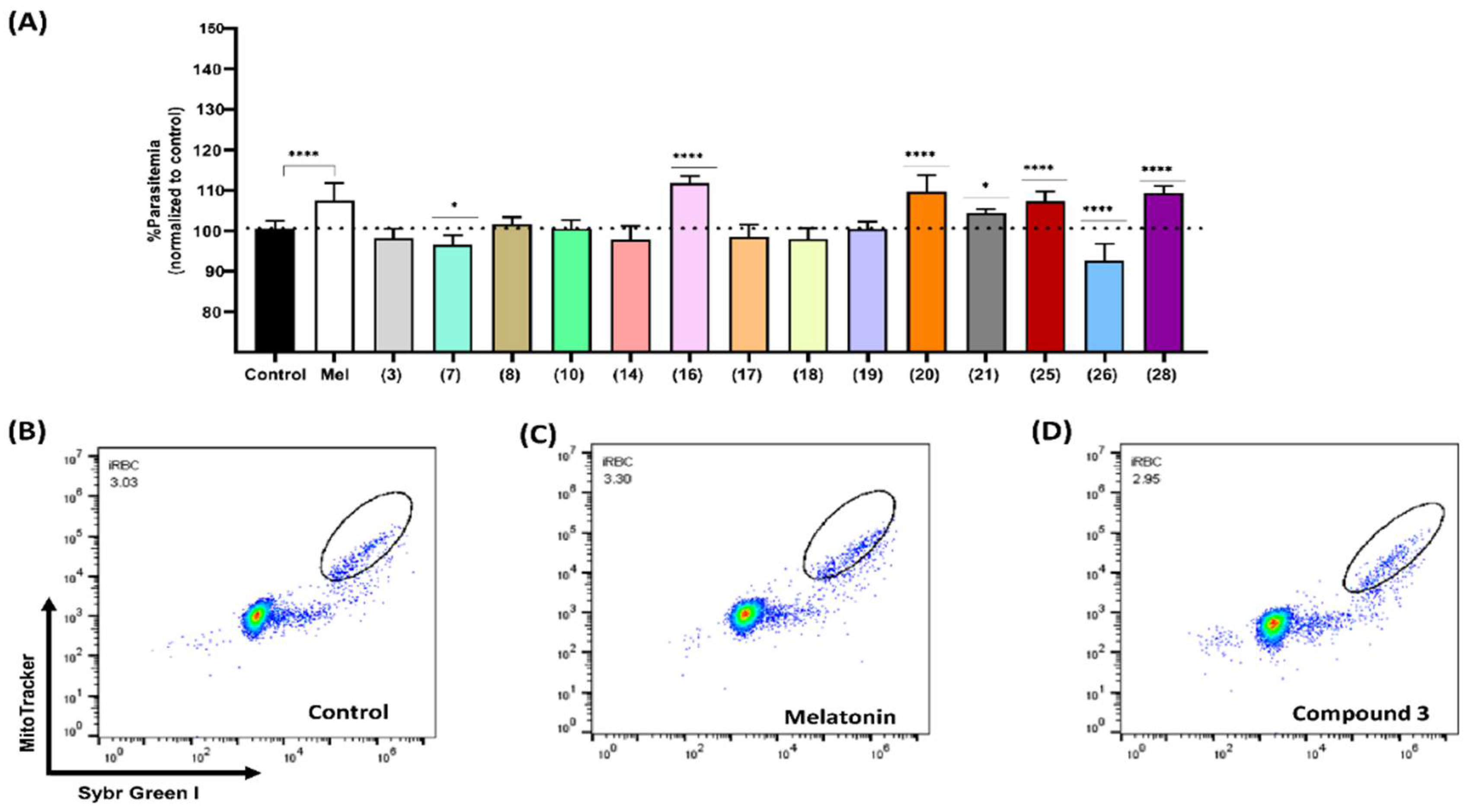
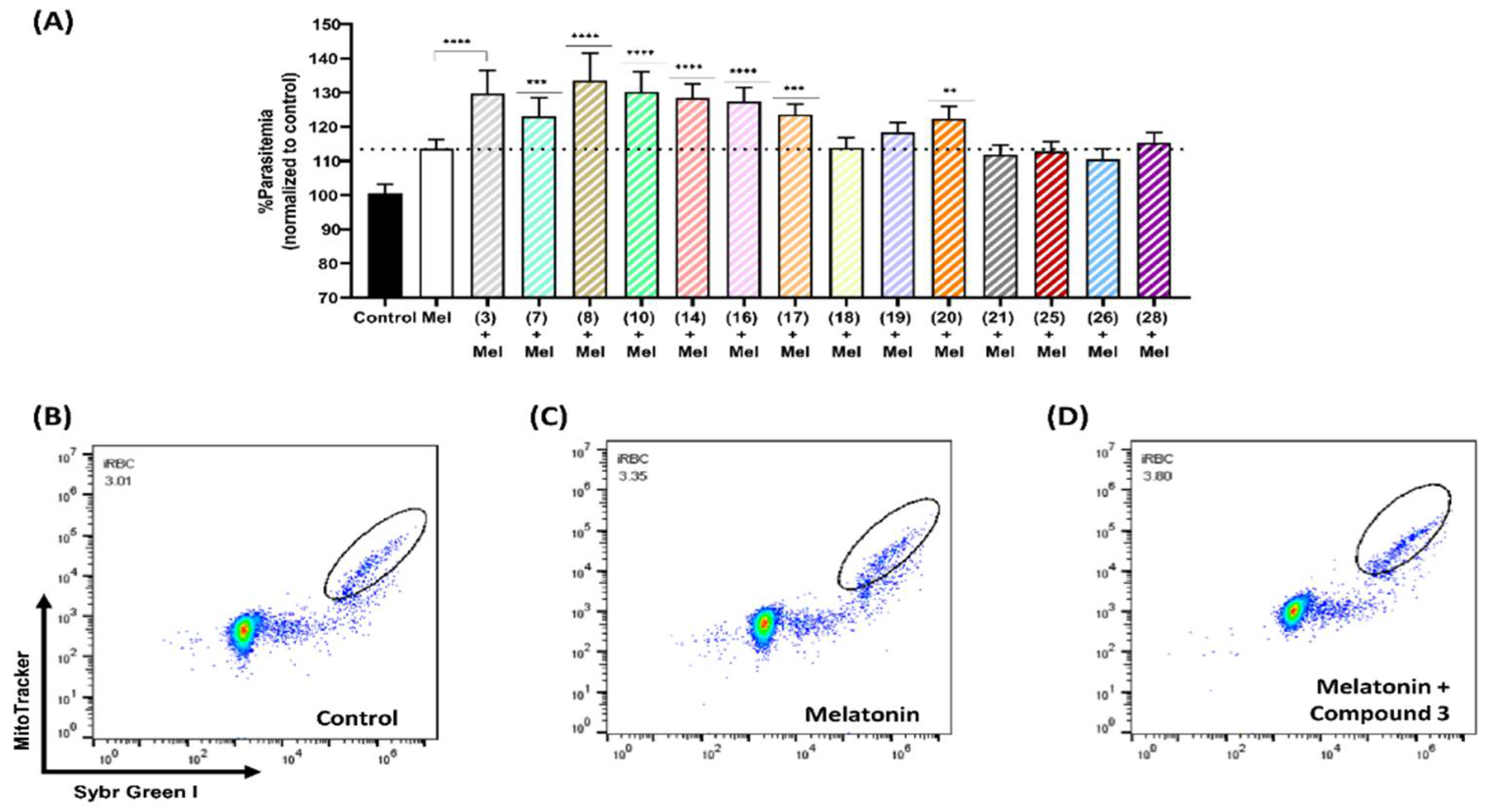
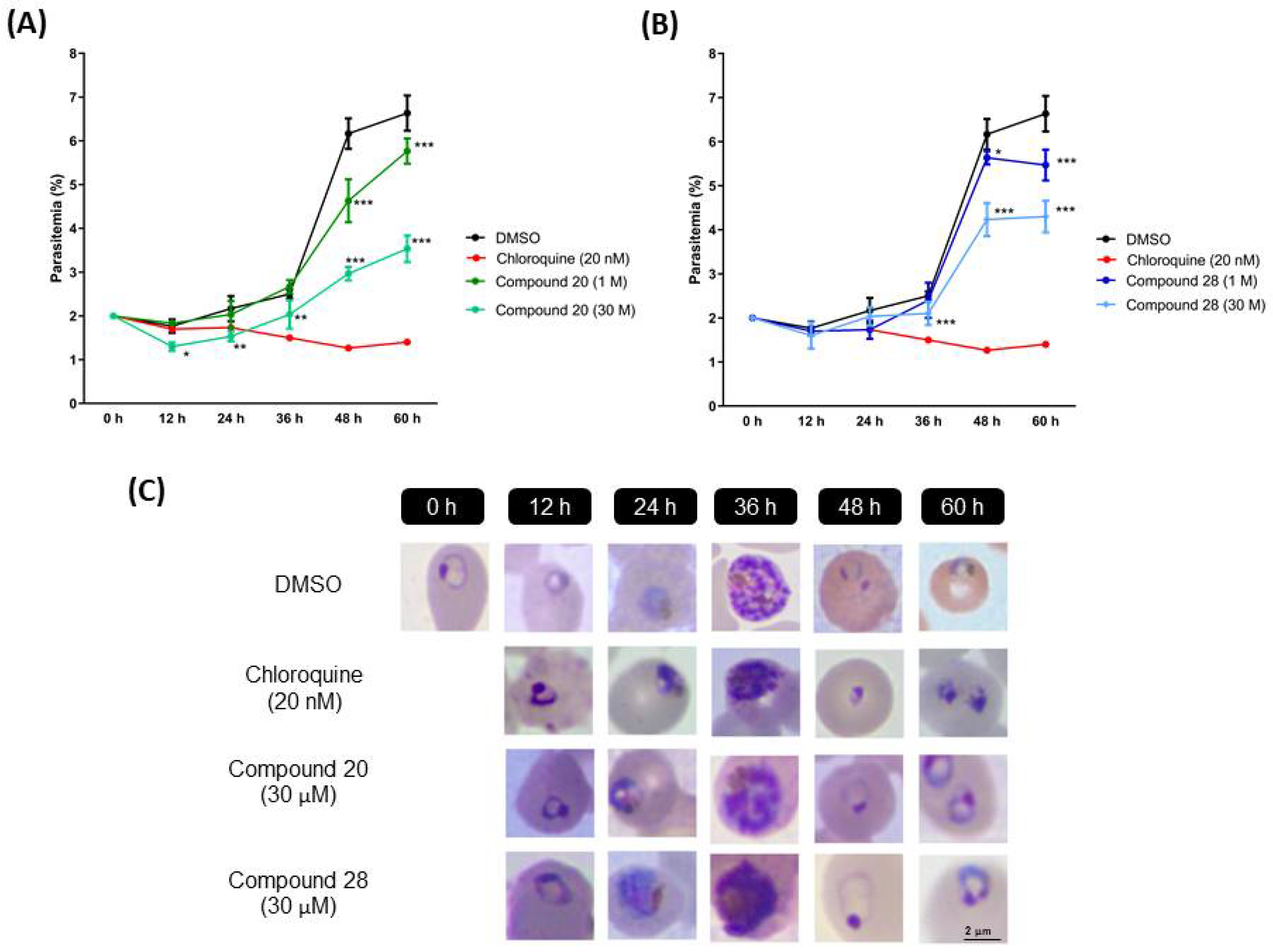
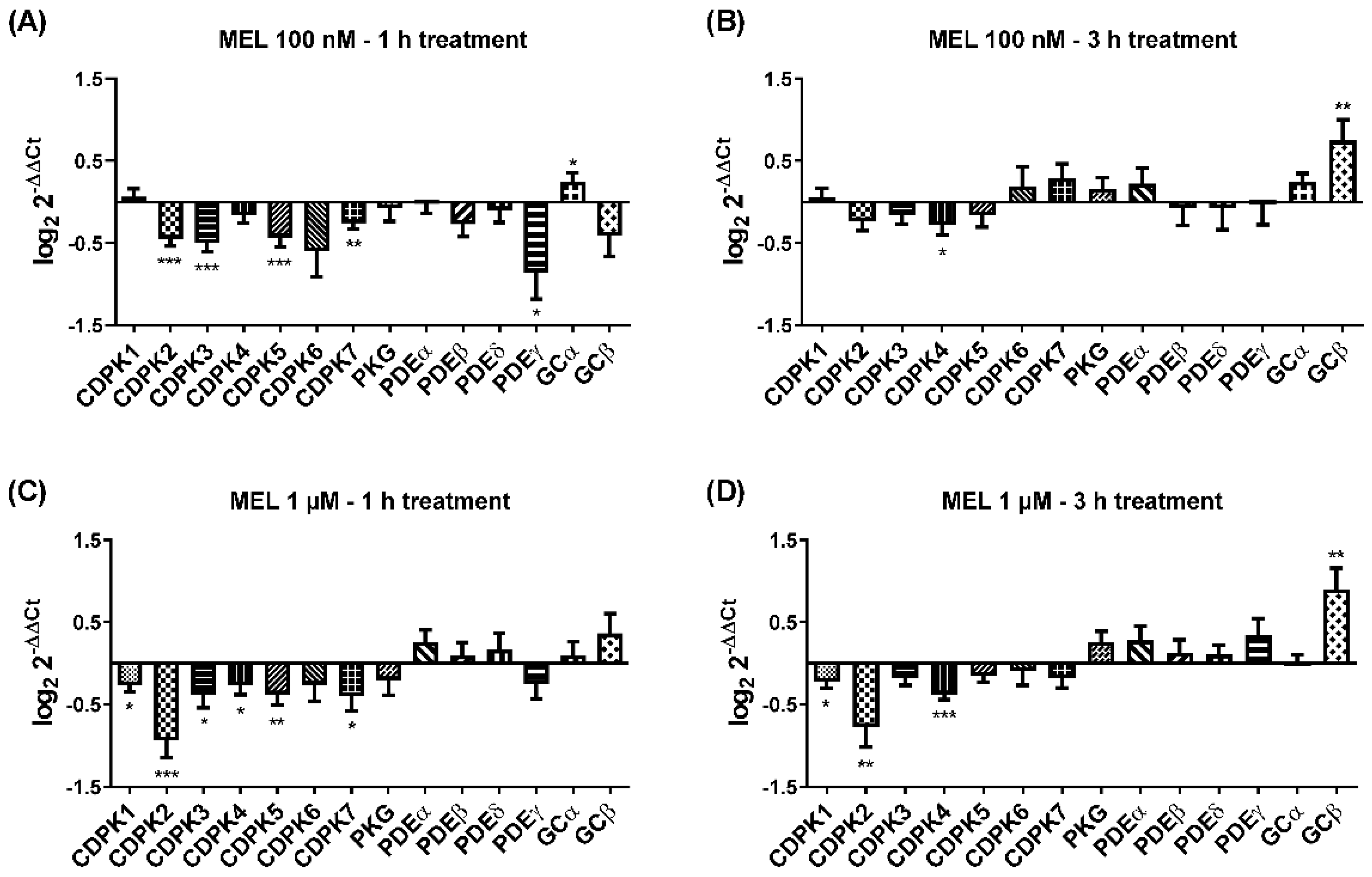
| Compound | IC50 ± SD Pf3D7 | IC50 ± SD PfDd2 | CC50 ± SD HEK293 | SI 3D7 | SI Dd2 |
|---|---|---|---|---|---|
(3) | 10.58 ± 5.19 µM | 17.97 ± 1.72 µM | 15.24 ± 1.36 µM | 1.44 | 0.84 |
(7) | 58.18 ± 2.45 µM | 55.42 ± 2.96 µM | 31.59 ± 4.03 µM | 0.54 | 0.57 |
(8) | 37.29 ± 3.58 µM | 43.29 ± 6.51 µM | >100 µM | >2.68 | > 2.31 |
(10) | 54.86 ± 2.25 µM | 43.62 ± 3.060 µM | >100 µM | >1.82 | > 2.29 |
(14) | 20.86 ± 2.97 µM | 37.08 ± 7.664 µM | 23.69 ± 8.540 µM | 1.14 | 0.63 |
(16) | 31.69 ± 5.09 µM | 48.50 ± 2.88 µM | 26.52 ± 8.70 µM | 0.84 | 0.55 |
(17) | 24.99 ± 2.90 µM | 35.37 ± 1.56 µM | 26.49 ± 4.67 µM | 1.06 | 0.75 |
(18) | 13.52 ± 3.24 µM | 15.72 ± 4.87 µM | 16.82 ± 2.63 µM | 1.24 | 1.07 |
(19) | 27.78 ± 2.03 µM | 39.92 ± 1.61 µM | 28.14 ± 5.46 µM | 1.01 | 0.70 |
(20)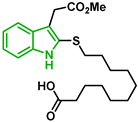 | 28.78 ± 4.86 µM | 8.72 ± 3.36 µM | >100 µM | >3.47 | >11.47 |
(21) | 19.10 ±1.78 µM | 16.86 ± 4.66 µM | >100 µM | >5.24 | >5.93 |
(25) | 26.47 ± 4.87 µM | 45.53 ± 4.84 µM | 13.14 ± 3.74 µM | 0.50 | 0.28 |
(26) | 13.48 ± 2.37 µM | 35.80 ± 4.64 µM | 34.72 ± 8.44 µM | 2.58 | 0.97 |
(28) | 31.75 ± 5.02 µM | 12.39 ± 0.59 µM | >100 µM | >3.15 | >8.07 |
| Chloroquine | 22.33 ± 4.17 nM | 199.05 ± 26.23 nM | ND | ND | ND |
Publisher’s Note: MDPI stays neutral with regard to jurisdictional claims in published maps and institutional affiliations. |
© 2022 by the authors. Licensee MDPI, Basel, Switzerland. This article is an open access article distributed under the terms and conditions of the Creative Commons Attribution (CC BY) license (https://creativecommons.org/licenses/by/4.0/).
Share and Cite
Mallaupoma, L.R.C.; Dias, B.K.d.M.; Singh, M.K.; Honorio, R.I.; Nakabashi, M.; Kisukuri, C.d.M.; Paixão, M.W.; Garcia, C.R.S. Decoding the Role of Melatonin Structure on Plasmodium falciparum Human Malaria Parasites Synchronization Using 2-Sulfenylindoles Derivatives. Biomolecules 2022, 12, 638. https://doi.org/10.3390/biom12050638
Mallaupoma LRC, Dias BKdM, Singh MK, Honorio RI, Nakabashi M, Kisukuri CdM, Paixão MW, Garcia CRS. Decoding the Role of Melatonin Structure on Plasmodium falciparum Human Malaria Parasites Synchronization Using 2-Sulfenylindoles Derivatives. Biomolecules. 2022; 12(5):638. https://doi.org/10.3390/biom12050638
Chicago/Turabian StyleMallaupoma, Lenna Rosanie Cordero, Bárbara Karina de Menezes Dias, Maneesh Kumar Singh, Rute Isabel Honorio, Myna Nakabashi, Camila de Menezes Kisukuri, Márcio Weber Paixão, and Celia R. S. Garcia. 2022. "Decoding the Role of Melatonin Structure on Plasmodium falciparum Human Malaria Parasites Synchronization Using 2-Sulfenylindoles Derivatives" Biomolecules 12, no. 5: 638. https://doi.org/10.3390/biom12050638
APA StyleMallaupoma, L. R. C., Dias, B. K. d. M., Singh, M. K., Honorio, R. I., Nakabashi, M., Kisukuri, C. d. M., Paixão, M. W., & Garcia, C. R. S. (2022). Decoding the Role of Melatonin Structure on Plasmodium falciparum Human Malaria Parasites Synchronization Using 2-Sulfenylindoles Derivatives. Biomolecules, 12(5), 638. https://doi.org/10.3390/biom12050638








